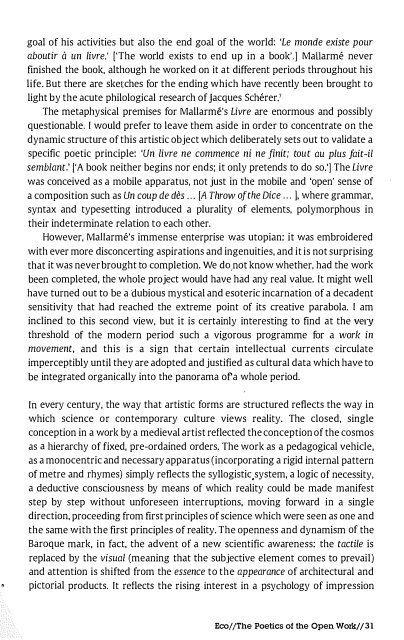You also want an ePaper? Increase the reach of your titles
YUMPU automatically turns print PDFs into web optimized ePapers that Google loves.
goal of his activities but also the end goal of the world: 'Le monde existe pour<br />
aboutir iJ un livre: ['The world exists to end up in a book'. 1 MaUarme never<br />
finished the book, although he worked on it at different periods throughout his<br />
life. But there are sketches for the ending which have recently been brought to<br />
light by the acute philological research of Jacques Scherer:'<br />
The metaphysical premises for Mallarm"'s Livre are enormous and possibly<br />
questionable. I would prefer to leave them aside in order to concentrate on the<br />
dynamic structure of this artistic object which deliberately sets out to validate a<br />
specific poetic principle: 'Un livre ne commence ni ne finit; tout au plus fait-il<br />
semblant: ['A book neither begins nor ends; it only pretends to do so:1 The Livre<br />
was conceived as a mobile apparatus, not just in the mobile and 'open' sense of<br />
a composition such as Un coup de des ... [A Throw of the Dice ... ]. where grammar,<br />
syntax and typesetting introduced a plurality of elements, polymorphous in<br />
their indeterminate relation to each other.<br />
However, MaJIarme's immense enterprise was utopian: it was embroidered<br />
with ever more disconcerting aspirations and ingenuities, and it is not surprising<br />
that it was never brought to completion. We dO,not know whether, had the work<br />
been completed, the whole project would have had any real value. It might well<br />
have turned out to be a dubious mystical and esoteric incarnation of a decadent<br />
sensitivity that had reached the extreme point of its creative parabola. I am<br />
inclined to this second view, but it is certainly interesting to find at the VeIY<br />
threshold of the modern period such a vigorous programme for a work in<br />
movement, and this is a sign that certain intellectual currents circulate<br />
imperceptibly until they are adopted and justified as cultural data which have to<br />
be integrated organically into the panorama ofa whole period.<br />
In every century, the way that artistic forms are structured reflects the way in<br />
which science or contemporary culture views reality. The closed, single<br />
conception in a work by a medieval artist reflected the conception of the cosmos<br />
as a hierarchy of fixed, pre-ordained orders. The work as a pedagogical vehicle,<br />
as a monocentric and necessary apparatus (incorporating a rigid internal pattern<br />
of metre and rhymes) simply reflects the syllogistic,system, a logic of necessity,<br />
a deductive consciousness by means of which reality could be made manifest<br />
step by step without unforeseen interruptions, moving forward in a single<br />
direction, proceeding from first principles of science which were seen as one and<br />
the same with the first principles of reality. The openness and dynamism of the<br />
Baroque mark, in fact, the advent of a new scientific awareness: the tactile is<br />
replaced by the visual (meaning that the subjective element comes to prevail)<br />
and attention is shifted from the essence to the appearance of architectural and<br />
pictorial products. It reflects the rising interest in a psychology of impression<br />
Eeol jThe Poetics of the Open Work/ /31








